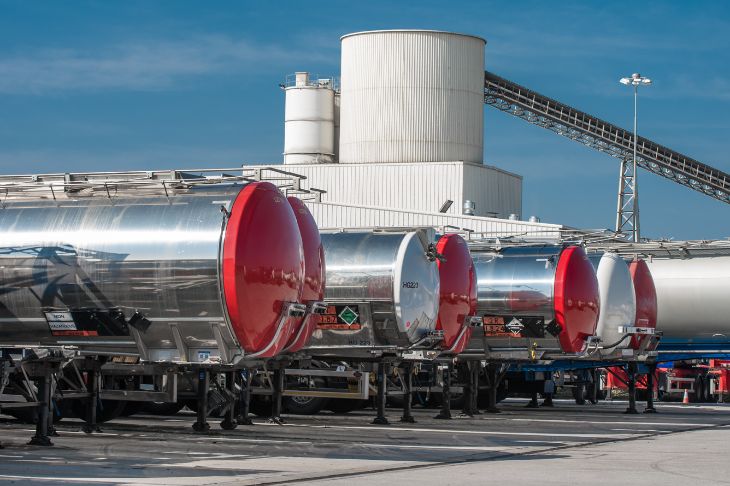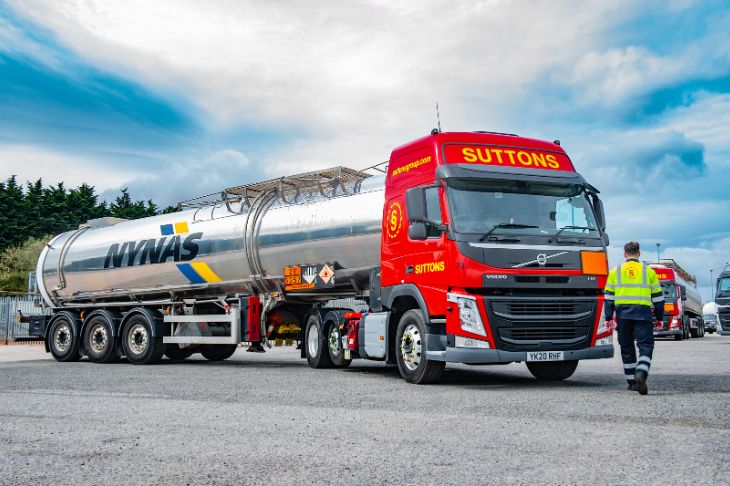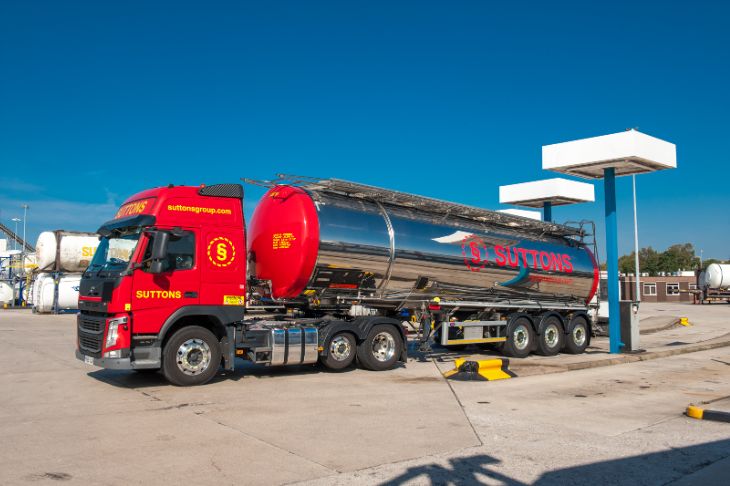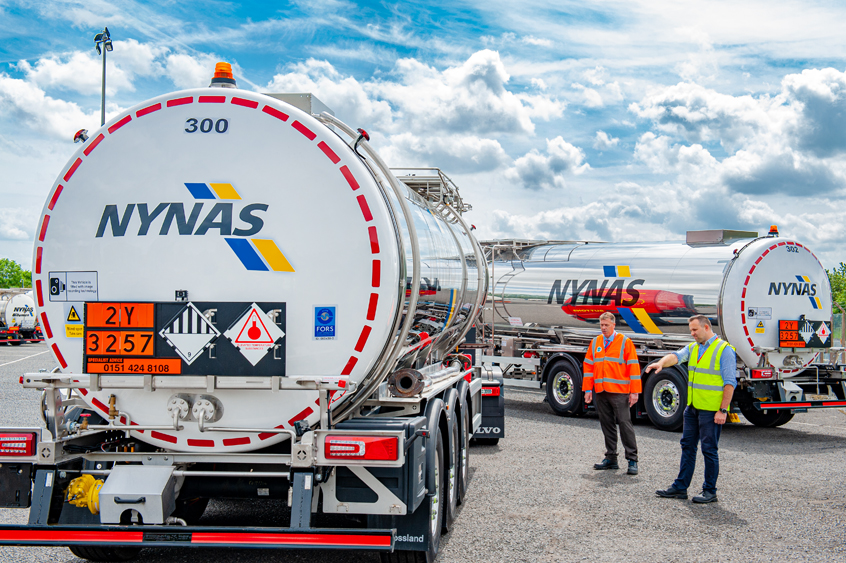Bitumen is a material that may not be as well known as other materials but plays a crucial role in the construction of the modern world.
It’s a material that requires delicate handling and must be transported in a certain fashion, otherwise, huge issues can occur.
Nonetheless, bitumen is transported safely worldwide, and Suttons Group plays a key role in the bulk transfer of bitumen across the UK.
This article will give a deep insight into what is involved with the transfer of bitumen in terms of road tanker logistics.
What is Bitumen and What is it Used For?

Bitumen, is a key component of asphalt and is a highly viscous and thick, black or dark brown hydrocarbon substance derived from the processing of crude oil.
It is a versatile material with a wide range of applications in various industries.
Bitumen is most commonly known for its use in road construction, where it serves as the binding agent in asphalt pavement.
Its adhesive and waterproofing properties make it an excellent choice for paving roads, highways, and airport runways.
Beyond road construction, bitumen finds application in roofing materials, waterproofing products, and as a sealant for various purposes.
It is used in the manufacturing of various industrial products, such as adhesives, paints, and as a component in the production of automotive and industrial lubricants.
Bitumen’s durability and resistance to environmental factors make it a crucial component in the modern construction and infrastructure sectors.
There are also other types of Bitumen that will include additives which change its properties so it can be used for other purposes.
A great example of this is polymer-modified bitumen (PMB).
PMB is a type of bitumen that has been modified with polymers to enhance its properties and performance.
The modification of bitumen with polymers involves the addition of polymer compounds to improve its elasticity, durability, temperature resistance, and other desirable characteristics.
The polymers used in this process can include styrene-butadiene-styrene (SBS) and others.
PMB is used in the construction of pavements that will be subject to heavy-duty traffic and extreme weather conditions such as bus lanes and airport runways
Why Bitumen Should be Transported at High Temperatures

Maintaining bitumen at high temperatures (around 140 – 220 degrees) ensures its fluidity, as this substance tends to solidify at lower temperatures, hindering its flow and causing handling difficulties.
The elevated temperature facilitates the efficient pumping and transportation of bitumen through pipelines and tankers, reducing the risk of blockages and ensuring a smooth and continuous flow.
Higher temperatures help to decrease the viscosity of bitumen, making it easier to handle during loading and unloading processes.
The increased fluidity also aids in achieving uniform and consistent application when bitumen is used in road construction and various industrial processes.
What is Involved with Transporting Bitumen?

Here’s a guide on what’s involved during the transportation of bitumen:
Transportation Containers
Bitumen is typically transported in specially designed containers or tanker trucks that can maintain high temperatures.
These containers are equipped with insulation and heating systems to keep the bitumen in a liquid state.
It’s not uncommon for these containers to be transported from ferry terminals if they are coming from outside of the UK.
They are also equipped to be sent around on railway networks and collected by trucks once they reach their destination.
Temperature Control
Bitumen’s viscosity decreases as temperature rises. Therefore, maintaining the correct temperature is crucial for its transport.
The usable properties of bitumen are lost when it gets below a certain temperature which only further cements the importance of temperature control.
The specific temperature requirements depend on the grade and type of bitumen.
Heating systems, such as electrical or steam heating coils (100 degrees), keep the bitumen within the recommended temperature range during transportation.
Hot oil heating systems can reach temperatures of 300 degrees.
Loading and Unloading
When loading bitumen, ensure that the storage tank, tanker truck, or container is clean and free from contaminants, as even small impurities can affect the bitumen’s properties.
For example, if the bitumen comes into contact with water it sets off a chemical reaction that means it cannot be used.
The chemical reaction causes the tanker to move so the only solution is to leave the tanker until the full chemical reaction is complete.
When unloading the bitumen it is required that you have the appropriate safe working space around that area of the site.
Before unloading, the customer representative and driver must complete the bitumen discharge permit (BDP) together.
Route Planning
Transportation routes are planned carefully to minimise the time bitumen spends in transit, as extended travel times can lead to cooling and increased viscosity.
Specialised bitumen tankers are designed to ensure laid temperatures are maintained over extended journeys.
However, it’s still prudent to ensure that the journey does not go over its intended time, which is why planning still must take place.
Be aware of local regulations and restrictions related to the transportation of hazardous materials, and ensure compliance.
In the UK this will be through Regulation 5 of the Carriage of Dangerous Goods and Use of Transportable Pressure Equipment Regulations (CDG) 2009.

Environmental and Spill Preparedness
The driver should inspect the hoses and valves to see if they are in fit condition before using them to pump out the bitumen.
Then the necessary valves can be released to ensure no leaks are coming from the bitumen tanker.
Once the hose is connected to the customer’s tank or tanker and the bitumen tanker, the bitumen can be transferred.
The representative at the customer’s site will operate the ground-based suction pump, while the driver opens the safety valve and bottom valve.
The discharge of the bitumen must be continually monitored to ensure there are no spillages or leaks.
If any leaks occur the transferring of bitumen must be stopped immediately.
Bitumen is usually delivered in 3 ways:
- Ground-based pump.
- Pressure discharge.
- Gravity.
In the UK around 70% of sites operate using a pressure discharge system.
Before unloading begins the driver must locate the safety shower facilities and ensure that they work. The shower must also be within 20 metres of the unloading site.
Documentation
Documentation plays a pivotal role in the transportation of bitumen, ensuring transparency, compliance with regulations, and efficient logistics.
Accurate documentation is essential for regulatory compliance and adherence to safety standards.
Transporting bitumen involves various regulations and guidelines concerning the handling, storage, and transportation of hazardous materials.
Proper documentation helps in demonstrating compliance with these regulations, reducing the risk of legal complications and ensuring the safety of both the environment and personnel involved.
Documentation provides a comprehensive record of the bitumen’s origin, quality, and specifications.
This information is critical for quality control and traceability.
It helps to track the source of the bitumen, ensuring that it meets the required standards and specifications for its intended use.
This traceability is crucial in case of any quality issues, as it allows for quick identification and resolution of problems.
Clear records detailing the quantity, batch numbers, and transportation routes enable better coordination between suppliers, transporters, and end-users.
This helps prevent delays, ensures timely deliveries, and enhances overall operational efficiency.
Bitumen Specific Training
Drivers who deliver bitumen will receive specific training on how to handle and transport bitumen safely.
Every individual engaged in the transportation and delivery of bitumen products is obligated to undergo training and obtain an ADR Vocational Training Certificate (VTC) specific to the relevant tank class.
Drivers are required to carry their ADR VTC at all times.
A specialised onboarding process concerning operations, safety, and emergency response protocols must be offered at each specific site, and it should be documented by personnel from the customer’s side.
What Hazards Are Involved with Transporting Bitumen?

Safety is a top priority when transporting bitumen. Ensure that personnel involved in the transportation process are adequately trained in handling bitumen and are aware of the associated risks.
Wear appropriate personal protective equipment (PPE), including gloves, safety glasses, a full face shield, and a neck cape.
If you’re within 6 metres of the delivery of bitumen you must be wearing appropriate PPE.
All PPE must be regularly checked, cleaned and replaced if necessary. This responsibility lies with the user as well as the company that provides the PPE.
Following the guidelines outlined in the ADR (European Agreement concerning the International Carriage of Dangerous Goods by Road), it is mandatory for both hauliers and bitumen suppliers to enlist the services of a Dangerous Goods Safety Advisor (DGSA).
The delivery vehicle is required to exhibit ADR markings, and it must be equipped under the stipulated ADR requirements.
What are ADR Regulations?
ADR regulations are a set of guidelines and standards developed by the United Nations Economic Commission for Europe (UNECE) to regulate the international transport of hazardous materials by road.
These regulations provide a framework for the classification, packaging, labelling, and transportation of dangerous goods to ensure the safety of both the public and the environment.
ADR covers a wide range of hazardous materials, including but not limited to chemicals, flammable liquids, explosives, and toxic substances.
Key aspects of ADR regulations include:
- Classification – ADR defines criteria for categorising substances and articles based on their inherent hazards.
- Packaging – Specific packaging requirements are outlined to ensure the safe containment and transport of hazardous materials.
- Marking and Labelling – Clear and standardised markings and labels are prescribed to identify the nature of the transported goods and communicate potential hazards.
- Documentation – Proper documentation, including shipping papers and transport instructions, is required to accompany the hazardous materials during transportation.
- Vehicle Requirements: – ADR regulations specify safety standards for vehicles transporting dangerous goods, including the use of appropriate equipment and markings.
- Driver Training – Drivers transporting hazardous materials must undergo specialised training and carry relevant certifications, such as the ADR Vocational Training Certificate (VTC).

Transporting Bitumen with Suttons Tankers
It’s clear to see that when it comes to transporting bitumen there is an extensive checklist of safety and training requirements.
All of which ensure the safe and timely delivery of bitumen.
In the UK, Suttons Group is one of the leading businesses that transport bitumen.
Our years of industry experience and exemplary safety record make us a wise investment when it comes to bitumen logistics.
If you work with bitumen and want to work with a leading logistics company that handles a wide range of dangerous goods, including bitumen, reach out to our team of experts today.
Our vast fleet and advanced tanker technology set us apart from the rest of the competition.